I’m personally not a fan of retractable Flexi leashes for most dogs because Flexi leashes teach dogs to pull.
I love to make fun of people who walk their dogs on these things.
You know, when someone’s trying to “reel in” his 100-pound German shepherd or when his Yorkie gets caught around two mailboxes and the dog has no idea how to back up.
Funny stuff.
However, That Mutt is open to different training tools, and I know many people use this type of leash with a lot of success.
I would much rather have a dog go for a walk on a retractable leash than no walk at all.
I’ll get into some pros and cons of retractable leashes and why I think they’re a poor choice for most situations (but not all).
IN THIS ARTICLE:
- What is a retractable leash?
- Flexi leash vs. other brands
- Alternatives to a retractable leash
- Cons of retractable leashes
- Pros of retractable leashes
- How retractable leashes teach dogs to pull
- Injuries caused by retractable leashes
- Safety tips for using a retractable leash
- How to fix a Flexi leash
What is a retractable leash?
A retractable leash is a leash that extends/retracts from a coil out to about 25 feet, depending on the specific leash. You know, like a tape measure! Or a yo-yo!
They typically have a bulky, plastic handle that stores the leash while it’s coiled up. The handle typically has a “brake/release” button.
Some retractable leashes are made of a nylon ribbon-like material. Others are made of a very thin cord.
Here is a picture of Mighty Paw’s retractable leash:
Flexi retractable leashes vs. other brands
The Flexi retractable leash is a brand of retractable leash that is made in Germany and sold all over the world.
If you are going to use a retractable leash, you can’t go wrong with the original Flexi brand.
Flexi leashes range in price on Amazon from $15 to about $32 depending on the size and specific design.
There are many, many other brands that have created their own retractable leash. There are endless choices, and unfortunately many are very cheap and will break easily.
I worked as a dog walker for many years and I saw a lot of very poorly designed, cheap, retractable leashes that would not lock properly and the thin cable would get caught up in knots, causing the whole product to malfunction.
The only other brand I recommend besides the original Flexi brand is Mighty Paw’s retractable leash. They’ve recently released an improved 2.0 version that has gotten good reviews.
This is not to say Mighty Paw’s retractable leash is necessarily better than others but it is the only brand I have used successfully other than Flexi. Both of these hold up over time.
No matter what brand you choose to buy, I highly recommend you read several reviews.
And to be clear, I generally do NOT recommend retractable leashes of any brand. I just know how popular these leashes are, especially with first-time dog owners or owners of small dogs. If you’re going to use one, go with the best quality.
Alternatives to a retractable Flexi leash
It’s simple:
Walk your dog on a standard 6-foot leash!
A standard 6-foot leather or nylon leash will give you the most control while walking almost any dog or puppy.
I personally prefer a leather leash due to the better grip. Nylon leashes tend to slide in my hands and that’s not ideal for controlling my strong sporting breeds. Nylon or rope leashes can also give you rope burn.
A good-quality leather leash should last decades and there are endless brands to choose from.
Benefits of a standard 6-foot leash for dog walking
Easy to grip: Traditional leashes have a loop on the handle so it’s easy to hold the leash and you’re less likely to drop the leash. Leather is soft in your hands and doesn’t give you rope burn.
You can use two hands: You can easily hold the loop with one hand and then grab further down on the leash with the other as needed for more control.
(You can’t use two hands for holding a retractable leash. Grabbing the thin cable piece of a retractable leash is pretty useless and could give you rope burn.)
Pros and cons of retractable leashes
Let’s get into some serious pros and cons of retractable leashes. I’ll start with some cons, followed by the benefits of a retractable leash. Because there truly are some benefits to them too! They’re not entirely bad.
6 cons of retractable leashes
1. Retractable leashes cause injuries to people and dogs.
Most of us have heard about someone getting caught up in the thin cable of a retractable leash and getting cut or rope burn.
Dogs can also get caught up in them. This could be the dog attached to the leash or a dog that crosses that dog’s path.
I know I’ve been out hiking or biking many times only to be approached by someone with a dog on a fully extended Flexi leash.
Usually, the owner just stands there with 20 feet of tight leash – a tripwire – with a yapping dog on one end! It’s hard to go around a 20-foot cord when you’re dealing with traffic and other pedestrians. What a nightmare.
There have been some serious, serious injuries caused by retractable leashes, which I will get into more later. Yes, any type of leash can cause injuries but retractable leashes are even worse.
2. Retractable leashes give you less control of your dog.
For obvious reasons, retractable leashes should never be used in congested areas such as a vet’s office, a pet store or busy walking paths unless the dog is 99% reliably trained. (Which most are not, let’s be honest.)
People have a hard enough time controlling their dogs while out and about on roads and sidewalks.
We’ve all been there … you’re out walking your dog only to glance up and see a giant goldendoodle charging at you on a retractable leash!
I was out biking recently with my dog at my side. A few blocks ahead of us, one of those “doodles” on a retractable leash almost got away from her owner who actually yelled at me to “hold on!” as though my dog and I were the problem.
We just quietly continued on our way. My dog was focused on running with me as the doodle barked and pulled on its “yo-yo” leash. The dog’s owner was unable to pull her back.

3. Flexi leashes teach dogs to pull.
I’ll get into more details later on why Flexi leashes teach dogs to pull. It’s definitely one of the most common problems with Flexi leashes.
Basically, the more the dog pulls, the more leash the dog is given. If the person is reluctant to allow the leash to extend, the dog pulls even harder until the owner gives in and allows more leash.
For this reason, I do not recommend walking your new puppy on a Flexi leash because it sets the puppy up for bad habits.
4. Retractable leashes are not ideal for big dogs.
I’m always surprised to see people walking German shepherds, Labs and even huskies – a breed bred to PULL – on Flexi leashes.
Obviously, if your large dog is well trained, then a Flexi leash can be a reasonable option. But we all know how the average dog behaves …
5. Flexi leashes are awkward to hold.
Flexi leashes are made of solid CHUNK of plastic and you have to keep your hand tightly around it to avoid dropping it.
Since most dogs are allowed to pull while on a retractable leash, the person must keep a tight grip the whole time. When the leash is tight, the dog will typically try to resist the tension by pulling harder.
I like to walk dogs on a loose leash.
When the dog and I are in sync, I could literally hold the 6-foot leash with my pinky finger because we are in a zone, walking at the same relaxed pace. If I were to drop the leash, the dog wouldn’t notice or care because the tension wouldn’t change.
With a retractable leash, this is nearly impossible because it’s not easy to maintain a light grip.
6. Dogs aren’t safe on a Flexi leash.
When a dog is on a fully extended retractable leash, they can get hit by a car or hit by a biker or get in the way of another dog at a blind intersection.
It’s not easy for most people to “reel” a dog in quickly on a retractable leash, especially if the dog is at all excitable or reactive around other dogs.
Funny thing is, retractable leashes are more popular in urban areas where there is more congestion and foot traffic. Now that I’ve moved to a more rural area in Montana, I really don’t see retractable leashes much at all.
7. It’s harder to walk two dogs together.
I know, I know. It can be done, and there are a few duos that I’ve walked together on retractable leashes. But it does become more difficult, for example, if you want to move both dogs to one side as you’re passing other dogs.
Or, if you need to stop and pick up after them, it’s just so much easier to hold two leather leashes in one hand (while you’re bent over picking up poop) than it is to hold two blocks of plastic in one hand.
If your dogs have solid obedience skills, then this is a non-issue.
8 pros of retractable leashes
Now, there is a time and a place for all dog training/walking tools. Here are some good examples where a retractable leash is helpful:
1. Retractable leashes give well-behaved dogs more freedom.
This is the most obvious benefit of a retractable leash. It allows you to give your dog more freedom to move, sniff and just be a dog while having the security of still being on a leash.
For well-behaved dogs who are under control, this is a great option.
Use a regular, 6-foot leash for walks and training until your dog is trained to heel or walk on a loose leash. Then, a retractable leash is great for the right scenarios for dogs who are well trained.
I will be the first to admit that a retractable leash is NOT a good option for my own dog, Remy! He is just too strong and excitable.
2. Flexi leashes are great for exercising a dog who can’t be off leash.
I would’ve loved to have this leash for my last foster dog. Lana really needed off-leash playtime, and I was unable to provide that for her. It was not safe to allow her off leash because she didn’t have the training.
I ran with her every morning for exercise, but a retractable leash would’ve helped provide my foster dog with additional exercise and playtime. I could’ve found some quiet, open areas to take her such as a softball field or soccer field while not in use.
Another benefit: A retractable leash allows a person with limited physical mobility to provide his dog with more freedom.
3. Use a Flexi leash for training a dog to stay.
I know some obedience instructors who like to use retractable leashes when teaching dogs to stay.
I prefer a 6-foot leather leash or a long 50-foot rope, but I can see why a retractable leash would be more convenient, assuming your dog is not going to lunge or bolt.
If that happens, it’s much easier to re-gain control with a 6-foot leash vs. a retractable leash.
Trying to re-gain control of a lunging dog on a retractable leash can be like reeling in a zoo animal with a yo-yo.
4. Use a Flexi leash to teach a dog to come when called.
Again, I prefer to drag a long leash while training basic obedience like stay and come. However, some people might prefer a retractable leash for whatever reason. Do any of you use one for this type of training? Let me know in the comments.
5. Retractable leash for transitioning your dog to heeling off leash.
This is my favorite benefit about the leash because I’m such a training nut:
The retractable leash allowed me to work with my previous dog Ace who was well trained. Using the retractable leash unlocked made it as though he was “off leash” because there could be no tension from me (unless I switched it back to the locked position for safety reasons).
This allowed my dog to make choices and it forced me to communicate with energy and sound vs. tugging him along. It really improved our relationship and prevented me from being lazy in my training.
6. Retractable leashes at the dog beach.
We used to live near an off-leash dog beach, however dogs were required to be leashed in the summer. I had often wished for a retractable leash to give my dog Ace more freedom for swimming and playing fetch.
Retractable leashes are nice for visiting the beach or lake in general because you can let your dog swim on a leash without getting in the water yourself!
7. Flexi leashes for camping and other adventures.
A retractable leash would be nice to keep in your car for various adventures where a leash is required such as hiking trails or national parks.
Of course, this is only a good idea for trained, well-behaved dogs and on wide paths or forest roads. A retractable leash is a terrible choice for narrow or single-track trails.
8. Walking a cat on a retractable leash!
I like to let my cat outside on a leash sometimes, and I can see how a retractable leash would be really useful for walking a cat vs. having them drag a long leash around, getting caught on everything.
How do retractable Flexi leashes teach dogs to pull
The simple concept here is that dogs quickly learn that pulling extends the leash.
The more the dog pulls, the more leash he is given.
When the dog hits the end of the leash, he will typically continue to pull. Then, the person lets out even more leash.
Pulling = Reward!
The reward is a longer leash and more freedom.
Sometimes, the person will hold out for awhile and not extend the leash when the dog pulls.
What most dogs will do then is keep pulling, harder, until the person gives in eventually and allows more leash.
Another factor is that if the dog actually does stop pulling, the retractable leash starts to lightly “reel him in”! So, he actually has to add a bit of tension in order to keep the leash extended!
If you would like some easy to follow leash-training tips, see my article on how to stop a dog from pulling. I recommend that before transitioning to a Flexi leash.
Of course, not everyone uses a Flexi leash in this way
1. Some people have trained their dogs to walk on a loose leash first and then transitioned the dog to a Flexi leash successfully.
2. Some dogs simply do not pull. Either they naturally want to stick close to their person or they just don’t have that kind of energy or interest in pulling.
3. And then, there are some people who truly do not care if the dog pulls. That’s totally fine if you want to allow pulling, as long as your dog is not causing a safety risk for others.
Pulling can actually be a good workout for the dog. You just might want a different setup than a retractable leash, but to each their own. For example, my dog and I run in a sport called canicross where he’s in a harness pulling me on a leash attached around my waist. We love it!
Injuries caused by retractable leashes
Yes, I’m going to go there.
Retractable leashes have gotten a bad rap for causing injuries. Let’s be clear that any type of leash or collar can cause injuries. It’s all about how you use the tool.
I am absolutely not in favor of banning retractable leashes just as I am not in favor of banning prong collars or e-collars. All of these tools are helpful when used properly for the right dog/human pair.
If we’re smart about using retractable leashes, we can avoid these types of injuries. So I’ll just mention some examples, briefly.
Retractable leashes can cause serious injuries to people
Serious injuries caused by retractable leashes are very rare, but when they do happen they tend to pop up in news stories or get circulated on social media.
For example, retractable leashes have unfortunately caused a few injuries involving amputated fingers. See this article from Consumer Reports. I do not know how many times this has occurred but it’s very rare.
Deep cuts or rope burn are way more likely to happen when someone accidentally gets wrapped up in the thin cord of a retractable leash as the dog is bolting. Or, the person gets injured when she tries to grab the thin cord as the dog is running at full speed.
ABC News also featured a fluke accident where a metal piece broke off of a retractable leash, flying back and hitting a girl in the eye. Of course, this could also happen with a poorly designed traditional leash.
The most common injuries from retractable leashes happen when the person simply trips over the extended leash. They might just stumble and skin up their knees or they might sprain an ankle. And like I mentioned, the thin cord can also burn a person’s skin if it gets tangled around their legs.
Injuries to dogs caused by retractable leashes
I do not have statistics on how often these types of injuries or accidents occur, so let’s assume serious injuries are very rare. Minor injuries and altercations are probably very common.
Here are four examples of retractable leashes injuring dogs:
1. The dog steps out into traffic on the fully extended retractable leash and gets hit by a car, biker or crashes into a runner.
2. When the leash is extended, the dog comes around a blind intersection and gets in a head-on fight with another dog.
3. The dog gets wrapped up in the thin cord of the leash as he is bolting at full speed. This can cause a serious cut to a paw or leg.
4. When the dog hits the end of the extended leash hard, the tension could injure her neck or spine. For this reason, retractable leashes should not be paired with prong or choke collars unless you’re certain your dog will walk on a loose leash.
5. When the dog hits the end of the retractable leash HARD, the sudden force might cause the person to drop the leash entirely. Since the dog is already running at full speed, he might continue bolting away.
4 safety tips when using a retractable leash
1. Teach your dog some obedience skills.
The retractable leash is great for the right scenarios or for dogs who are well trained.
Work on obedience until your dog is rock solid, even in new environments and even around strange dogs and other distractions. If your dog has a high level of obedience, he will be well behaved no matter what type of leash you use (or no leash at all).
So if you just adopted a dog or if you’re walking some other dog you don’t know, ditch the Flexi leash until later.
If your dog stays when told, comes when called, heels and doesn’t react to other dogs, then go for the retractable leash! Heck, walk your dog with a piece of string for all I care.
2. Don’t allow your dog full freedom on the retractable leash in urban or busy areas (good grief!).
3. Pay attention to your surroundings so you maintain control of your dog around potential distractions. Be aware of “blind” intersections.
4. Practice locking and unlocking the button before using it on your dog so you’re comfortable with the settings.
How to fix a Flexi leash
Sometimes these types of leashes wear out over time. The Flexi leash brand is built to last, but the cheaper knockoff brands can easily break. The locking button will stop working or the thin cord will become full of knots, making the product useless.
What to do when this happens?
You throw it away.
Save yourself some stress and just go by a traditional leash instead.
OK, now I’d like to hear from you!
Do you like to use a retractable leash?
Do you believe Flexi leashes teach dogs to pull?
Let me know in the comments!
Resources:
1. If you’re going to use a retractable leash, use a high-quality brand.
2. Get all of That Mutt’s dog training tips here.

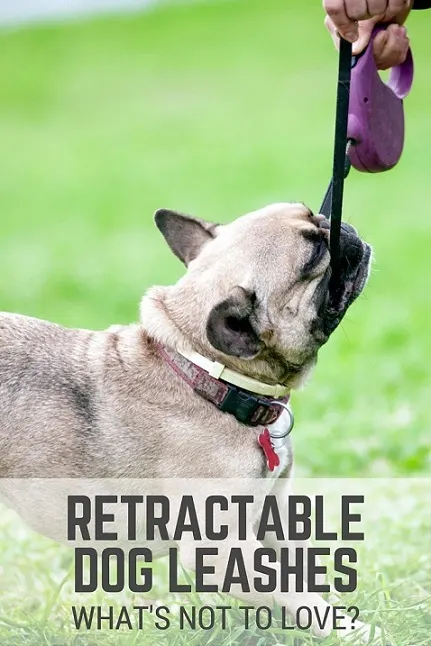
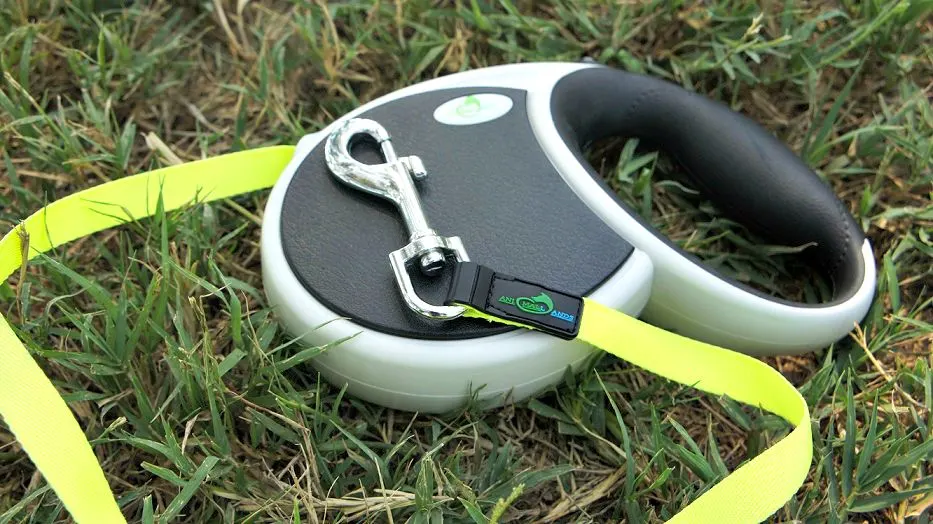
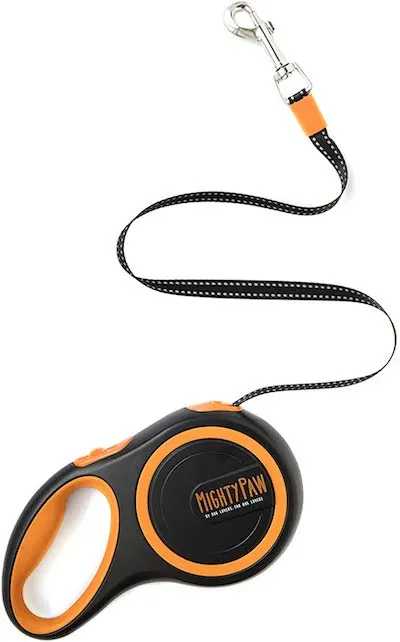
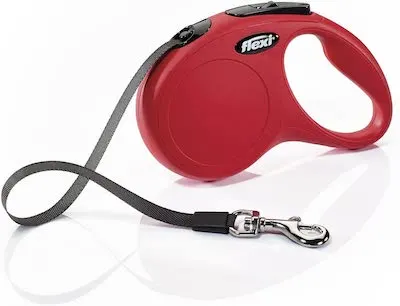
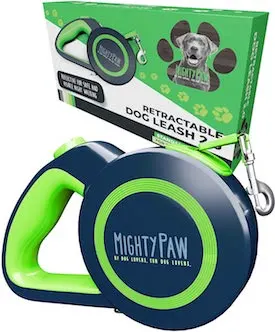
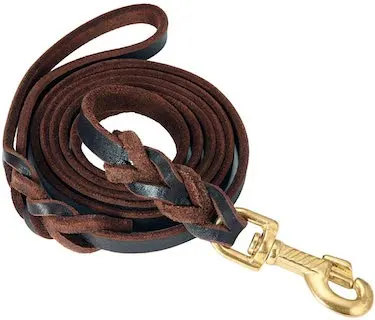
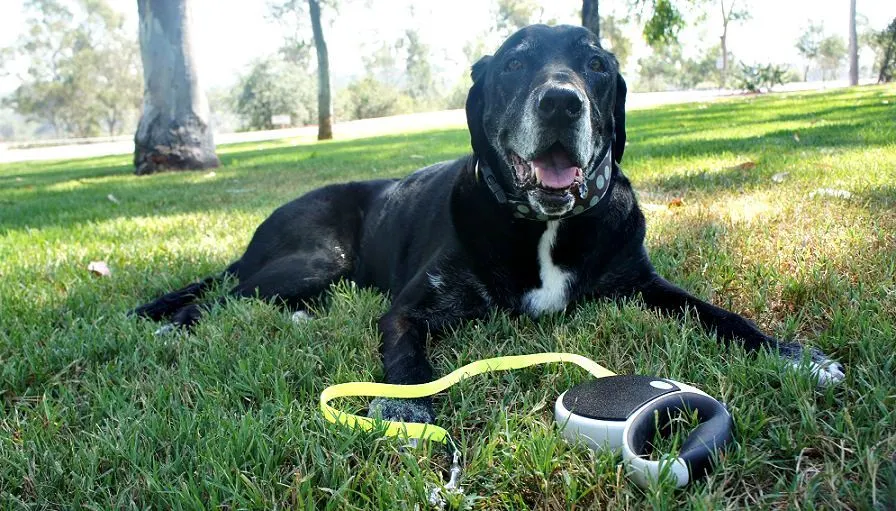


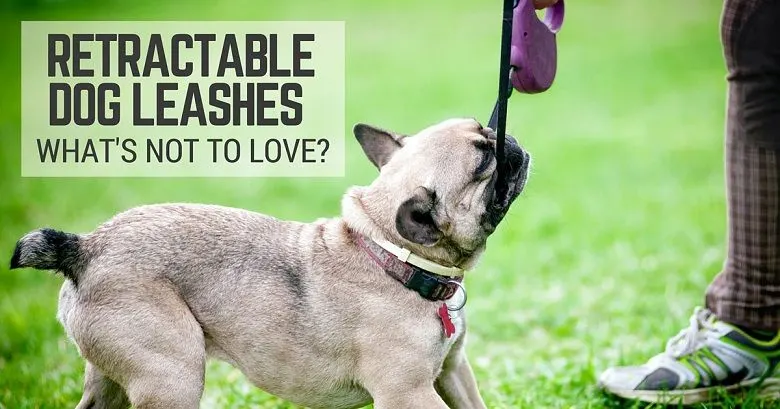

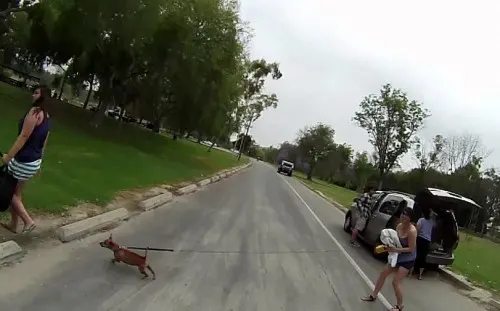
Bill
Monday 16th of August 2021
I have an 80lb Pitt Bull and use a Flexi Explore 26ft leash everyday. I don't have any issues controlling my dog with this leash. I don't try to control the dog with leash extended. Not gonna work. Be aware of your surroundings. I keep my dog within 3-4 ft if I need to control her from possible problems ie: other dogs, people or any other possible distraction. Otherwise she has free reign to do what she wants.
Darcie
Saturday 2nd of November 2019
I absolutely love my Flexi leash for my 100 lb dog. Taking him for a walk when I switched to the Flexi leash was like night and day. I tried different harnesses and the gentle leader, too. But the Flexi leash gave him the room he needed to feel like a dog. We have walked him in areas off the leash and he always stays close and responds immediately to being called. He has also been through a lot of training. But he always pulled on a short leash. With the Flexi leash and can walk ahead and “scout”. He can stop and sniff, an ultimate pleasure for a dog who spends 99% of his life in a house and fenced back yard. And when he does these things, he is not jerking me around and he is not constantly pulling on the leash. He does not go to the end and keep pulling the entire time. He prances around a little, plays some, and sniffs lots of stuff like a dog should be able to do. All of this without pulling me or stopping me. So we can both enjoy our walk. Now that he is 3 and a little older, he even does better on the short leash that we have. He is a big dog so we got the big dog leash. We know how to stop it and pull it in when someone is approaching. We are always vigilant about watching for people and other animals so that we can be prepared and have him closer an more under control when we need it. I’m fact, I just got another one for our 5-month-old puppy who is 50 lbs and also loves to pull on the leash. We just took them for a second walk today, this time with the new leash and once again, it was like night and day. He had enough space to do his puppy/dog thing while we take a nice walk. Our dogs stay close regardless of whether they have a leash on or not. They don’t run off. But the traditional leashes don’t give them enough space to enjoy themselves. No matter how good dog owners are, most dogs spend too much of their lives in too small a space with too little stimuli. The least I can do is give my dogs a little more pleasure during their walks.
Charle
Wednesday 9th of October 2019
I'd respectively suggest that this article should be titled, "10 reasons not to buy a dog".
If you're lazy, if you don't want to take the time to train a dog, then don't get a dog in the first place. If you care about the dog, your neighbors and the space around you, then there isn't one tiny bit of an issue with long flexi leashes. In fact, they're really beneficial to the health, safety and training of dogs.
- They safely allow an owner to work on recall outside of an enclosed space. - They allow a dog to warm up by moving if there's a long walk to a dog park, and ample space alongside the path to get there (6 foot lead = freezing cold dog that can't run to keep his temp up if there's no safe space nearby that's enclosed) - They retract to 2 feet long, which is shorter and more in-control than someone wildly letting their dog mosey about 6 feet from them on a normal lead.
John
Wednesday 19th of June 2019
Sorry, but I disagree.
I've been using Flex leashes at least back into the 1990s when the company making them was only in Germany. I use the heavy duty one which is about 26 foot long and has screws so you can open it up for simple repairs if needed. They have proven to be incredibly durable and have never broken on me.
I have used them with a 125 lbs Rottweiler, a 160 lbs Rottweiler, a 165 lbs Great Dane, and my current small 60 lbs Doberman puppy. es, you do need to know how to use it and be careful around other people. But, it is very easy to bring the dog in close, shortening the leash as much as needed, when around others.
I like them because among other things, I buy one and it lasts many years. The older one I have right now I purchased mid May of 2013 and it still works fine, though it is clearly used. It allows me to let my dogs effectively run free to some extent while actually maintaining them on a hard leash for safety, something the "Law" requires, even if a number of people regularly violate this law. I also find it useful for teaching, because I can give command to sit and stay, then walk up to 26 feet away, wait, and then give the command to lay down, stand, come, to stop while coming, etc.
Rebecca
Sunday 3rd of February 2019
I agree about the dangers of Flexileashes. I have one that we got for our excessive pulling mix breed. We didn't know that it would be any different than any other leash. So many people around our area use them, and it seemed like a good idea for being able to adjust for play versus walking.
However...
It wasn't long after we started using it we started seeing the downsides. It was too tempting to give in to his pulling rather than keeping him close. Second, it is a recipe for pulled muscles in the bicep and forearm, and possible sprained wrists. My daughter used it to walk him, and he lunged when she wasn't expecting it and it bent her wrist in a really bad angle due to the handle. Thirdly, but no less important, the mechanisms that stop the extention of the leash are not durable. After a couple months of use, ours will completely let go if he pulls, regardless how hard you are pushing the button, or even if it was locked. We use a regular leash now for both of our high-energy dogs, and only break out the p.o.s flexi for playing in the field across from us or in the yard where it is safe.